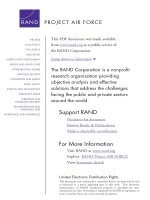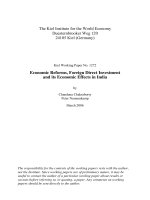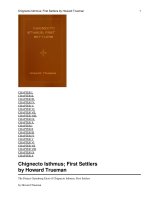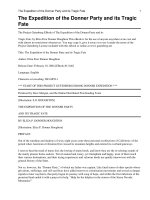- Trang chủ >>
- THPT Quốc Gia >>
- Hóa
Magnetism and its uses
Bạn đang xem bản rút gọn của tài liệu. Xem và tải ngay bản đầy đủ của tài liệu tại đây (5.22 MB, 14 trang )
Physical Sciences
Standards
Preview
Standard Set 1. Physical Sciences
1. Electricity and magnetism are
related effects that have many useful
applications in everyday life. As a
basis for understanding this concept:
1.b. Students know how to build a
simple compass and use it to detect
magnetic effects, including Earth’s
magnetic field.
1.c. Students know electric currents
produce magnetic fields and know
how to build a simple electromagnet.
Genre
Nonfiction
Comprehension Skill
Main Idea and Details •
•
•
•
1.d. Students know the role of
electromagnets in the construction of
electric motors, electric generators,
and simple devices, such as doorbells
and earphones.
1.e. Students know electrically charged
objects attract or repel each other.
1.f. Students know that magnets
have two poles (north and south) and
that like poles repel each other while
unlike poles attract each other.
1.g. Students know electrical energy
can be converted to heat, light, and
motion.
Text Features
Captions
Call Outs
Diagrams
Glossary
Science Content
Magnetism
Scott Foresman Science 4.2
ISBN 0-328-23544-X
ì<(sk$m)=cdfe f< +^-Ä-U-Ä-U
by Anne Cambal
Vocabulary
electromagnet
generator
magnetism
magnetic field
magnetic poles
by Anne Cambal
Picture Credits
Illustration
3 Tony Randazzo; 7 Peter Bollinger.
Photographs
Every effort has been made to secure permission and provide appropriate credit for photographic material. The
publisher deeply regrets any omission and pledges to correct errors called to its attention in subsequent editions.
Unless otherwise acknowledged, all photographs are the copyright of Dorling Kindersley, a division of Pearson.
Photo locators denoted as follows: Top (T), Center (C), Bottom (B), Left (L), Right (R), Background (Bkgd).
Opener: (Bkgd) Petr Svarc/Alamy Images; 2 (L) ©GK Hart/Vikki Hart/Getty Images; 3 (BR) Alex Bartel /Photo Researchers,
Inc.; 16 (BL) Used with permission of GE Healthcare. (T) Phototake; 17 (TR) Apple Computer, Inc., (B) Tim Ridley/DK
Images; 9 John Bulmer/DK Images; 21 ©Comstock Inc.; 22 (Inset) David R. Frazier/The Image Works, Inc., (Inset) Photo
Researchers, Inc.
ISBN: 0-328-23544-X
Copyright © Pearson Education, Inc. All Rights Reserved. Printed in the United States of America.
This publication is protected by Copyright, and permission should be obtained from the publisher prior to any
prohibited reproduction, storage in a retrieval system, or transmission in any form by any means, electronic,
mechanical, photocopying, recording, or likewise. For information regarding permission(s), write to
Permissions Department, Scott Foresman, 1900 East Lake Avenue, Glenview, Illinois 60025.
1 2 3 4 5 6 7 8 9 10 V010 13 12 11 10 09 08 07 06
Magnetic Fields
The objects shown on these two pages are made from
different materials. They work in different ways. But each one
is either a magnet or has a magnet inside it. Magnets attract
iron, steel, and some other metals through their magnetism.
Magnetism is a force that acts on moving electric charge and
on magnetic materials that are near a magnet.
The magnets that we use every day, such as the
refrigerator magnets that we use to post things, are usually
pretty small. They contain a small amount of magnetism.
But other magnets, such as the ones that keep maglev trains
running, are much larger. “Maglev” stands for magnetic
levitation. The magnetic force created by the electric current
running through maglev train tracks lifts the entire train off
the tracks. Magnets create pushing and pulling forces to move
the train along the track.
Magnetism makes a compass needle
(left) point in different directions. It
makes a maglev train (below) run.
The moving electric charge in
fans and flashlights produces
magnetism.
2
3
How Magnetic Fields Work
Different Magnets’ Magnetic Fields
A magnet’s magnetic field can cause objects to move
closer to or farther away, without actually touching the
magnet. A magnetic field is the space around a magnet in
which magnetic forces operate. A magnet’s magnetic field
surrounds it in all directions.
You cannot see a magnetic field. But you can use iron
filings to outline it. If you place iron filings near a bar magnet,
they will line up to recreate the magnetic field. They show the
lines of force that surround a magnet.
Look at the picture at the bottom of the page. It shows a
horseshoe magnet. Its shape is totally different from the shape
of the bar magnet on page 4. It is also shaped differently from
donut-shaped magnets. Magnets’ different shapes cause their
magnetic fields to be shaped differently. But there are patterns
to all magnets’ magnetic fields. Each magnet’s magnetic field
has curved lines of force spreading out from each pole. The
lines run from pole to pole. At each magnet’s pole the lines of
force are closest together and the magnetic field is strongest.
A Magnet’s Poles
Notice that the filings in the picture are gathered near
the ends of the magnet. They have been attracted to the
magnet’s magnetic poles. Magnetic poles are the two ends
of a magnet. One pole always points north, while the other
pole always points south. A magnetic field is strongest at a
magnet’s poles.
Compare the horseshoe
magnet’s magnetic field
with that of the bar
magnet.
Iron filings show this bar
magnet’s magnetic field.
4
5
The Behavior of Magnetic Fields
What happens with broken magnets?
A magnet’s like and unlike poles are similar to like and
unlike electric charges in the rules they follow. Just as unlike
electric charges attract, so do unlike magnetic poles. And like
magnetic poles repel, just as like electric charges do.
The picture shows two magnets that are repelling each
other. The magnets’ north poles are trying to push away from
each other. But what would happen if one magnet’s north
pole were placed next to the other magnet’s south pole? The
magnets would try to pull together. You can scatter iron filings
around magnets that are attracting and repelling each other.
The filings will show how magnetic fields change shape based
on attraction and repulsion.
Suppose you took a magnet and broke it in two. What do
you think would happen? If you predicted that there would be
two new magnets, you are right! But there is more to it. Each
new magnet would have a north pole and south pole. You
cannot have a magnet with only one pole. It must have an
opposite pole. So magnetic poles always come in pairs.
Pieces of a broken magnet may
look different. But they still work
like all other magnets.
Attraction pulls iron filings together (above).
Repulsion pushes them apart (below).
6
7
Magnetic Effects
Compass needles are a type of magnet. A compass
needle always swings so that one end points north and the
other points south. Many ancient sailors used compasses to
navigate. When Christopher Columbus crossed the Atlantic
Ocean over 500 years ago, he used a compass. William
Gilbert, working about 400 years ago, proposed that the Earth
was like a magnet. He believed that it was surrounded by a
huge magnetic field.
Today’s scientists believe Gilbert was right. But how can
they be sure? They cannot, since they cannot see inside Earth.
But they suspect that Earth’s outer
core is made of very hot liquid
magnetic
iron. Earth’s rotation causes
north pole
electric currents to flow in
the iron. This creates a
North Pole
magnetic field.
Magnetic Minerals and Poles
For thousands of years, people have noticed that certain
rocks and minerals have magnetic properties. Magnetite, also
known as lodestone, is highly magnetic. Sailors would use
lodestones as a kind of early compass.
Magnets have magnetic poles. Earth’s magnetic poles are
different from its geographic poles. The geographic poles are
on Earth’s axis, the invisible line around which Earth spins.
But the north magnetic pole is almost 1,000 kilometers from
the geographic North Pole, in Canada. The south magnetic
pole is found in the ocean near Antarctica.
Magnetite’s magnetic field
pulls iron filings toward it.
axis
Earth’s magnetic field
and related features
South
Pole
magnetic
south pole
8
9
How Compasses Work
Studying Earth’s Magnetic Field
A compass’ needle is magnetized. It is set within the
compass so that it can turn in a complete circle. No matter
where you travel with a compass, one end of the needle will
always point toward Earth’s north magnetic pole.
But why does the compass needle do this? It is attracted to
Earth’s magnetic field. Look at the picture on pages 8 and 9.
Our planet’s magnetic field is shown by lines that run north
and south between the magnetic poles. The compass needle
lines up with Earth’s magnetic field.
As you know, magnetite is highly magnetic. It is so
magnetic that it can affect a compass needle. What happens
if you walk by a piece of magnetite while holding a compass?
The magnetite’s magnetic field causes the compass needle to
swing toward it! After you walk past the magnetite, the needle
will swing back toward the north magnetic pole.
Compasses are good at showing us Earth’s magnetic field.
But any magnet, not just a compass, can be used to detect
it. Take a simple magnet and tie it to a string. Then hold the
string in your hand so that the magnet hangs in the air. After
a few seconds, the magnet’s poles will swing so that the north
pole is pointing north and the south pole is pointing south.
You can check your hanging magnet against a compass to
find out which pole is which. Place the compass far enough
away from the magnet so they do not affect each other. The
magnet’s north pole points the same way as the north pole
of the compass needle. You can then label the poles of your
hanging magnet.
Compass needles swing away
from the poles if a magnet is
placed near them.
10
11
Making Your Own Compass
Using Your Compass
All you need to make your own compass are a few simple
objects. First, find a needle, bowl of water, piece of cork or
sponge, and magnet. Then rub the needle on the magnet.
Make sure that you rub it quickly and in the same direction
every time. This gives the needle a magnetic field.
Next, place the needle on the cork or sponge. Put the cork
or sponge in the bowl of water, with the needle. Make sure
the needle is floating above the water and that the water is
still. The needle, like a compass, will point north and south
once it lines up with Earth’s magnetic field. Like with your
hanging magnet, place a regular compass a safe distance away
from the needle. Then you can figure out which end of the
needle is the north pole and which is the south pole.
Your compass needle is now made. But you still have to
mark the bowl of water as if it were a compass. Write north,
south, east, and west on the edges of the bowl. Make sure the
words are equally spaced around the bowl. Then turn the
bowl until the needle is pointing at where you wrote north.
You now have a working compass! Your new compass would
be difficult to use in the woods. But it works just the same as a
regular one.
Homemade compasses work like
all other compasses. Their needles
are attracted to nearby magnets.
Rubbing a needle on a magnet will
give the needle a magnetic field.
12
13
Electric Currents
and Magnetic Fields
Hans Christian Oersted was a Danish scientist. In 1820,
while running electric current through a wire, he saw
something interesting. Each time he turned on the current,
the needle on a nearby compass moved. What Oersted had
discovered was that a magnetic field is made by a flowing
electric current. Oersted had demonstrated the relationship
between magnetism and electricity.
Michael Faraday was a British scientist who built on
Oersted’s work. In 1831, he saw that electric current could
be made by moving a magnet inside a wire coil. Faraday had
invented the dynamo, a device which makes electricity by
using a moving magnet.
You can see how a magnet makes electricity by watching
a meter that measures electric current. The meter needs to
be attached to a magnet that is inside a coil. If the magnet is
not moved across the coil, electric current will not flow. The
meter will read zero.
Suppose the magnet is moved back and forth across the
coil. Electricity will flow through the wire to the attached
meter. The needle on the meter will move past zero.
Hans Christian Oersted
Michael Faraday
14
15
What is an electromagnet?
Electromagnets All Around Us
Each coil of wire within a dynamo makes up an
electromagnet. An electromagnet is a coil of wire with many
loops through which an electric current passes. As the current
flows through an electromagnet, it creates a magnetic field.
If you place a magnetic bar inside of the coil of wire, the
electromagnet’s magnetic field will become stronger. You can
also add more coils, or wrap the coils closer to each other.
Each of these changes will make the electromagnet’s magnetic
field stronger. You can also strengthen the electric current that
runs through it. This can be done by using more batteries. A
stronger electric current will make a stronger magnetic field.
We use electromagnets every day without realizing it. For
example, every time you turn on a computer, you are using
an electromagnet. Its electromagnet is very different from the
kind you just read about. Computer electromagnets are found
inside computer hard drives.
The electromagnet that you read about on page 16 is
the simplest kind. Today, there are many more types of
electromagnets. They are different sizes and shapes. They
have different purposes. But electromagnets work only when
an electric current flows through them. Then they create their
magnetic field.
The Magnetic Resonance Imaging
(MRI) machine uses magnetic
fields to make images of the
human body.
Laptop computers
contain hard drives that
use electromagnets.
16
17
Electromagnets in Machines
That Make Sound
The speakers for a sound system use electromagnets.
These electromagnets create changing magnetic fields. The
magnetic fields change as the current changes. The changes
to the current cause motion in the speakers. This motion, also
known as vibrations, makes the sound waves you hear.
Earphones are another kind of sound system. Each set of
earphones contains a metal disc. The disc is located in front
of an electromagnet. As with speakers, the magnetic field of
the earphones changes as the electric current flowing through
them changes. The changes in the earphones’ magnetism
cause the metal disc to vibrate. The vibrations cause the
sound waves that you listen to.
Earphones and speakers work
in much the same way. Both use
electromagnets.
Speakers use electromagnets to create
magnetic fields. These fields help create the
sound waves that you hear.
18
19
Electrical Energy
into Mechanical Energy
Along with speaker systems and earphones, we use
many devices that spin. These devices use motors to change
electrical energy into mechanical energy. The energy involved
in motion is mechanical energy.
A rotor is found at the center of a simple motor.
A battery inside of the motor creates an electric
current. The electric current makes a
magnetic field in the rotor. The two
poles of the rotor’s magnetic
field repel and attract the poles
of the magnets that are inside
Battery
the motor. This makes the
rotor turn.
Making Motion
Once the rotor spins halfway, a commutator takes over.
It reverses the direction of the current. This keeps the rotor
turning in the same direction, instead of changing directions
halfway.
As the rotor spins, it turns something called the axle. The
axle is often attached to something that spins, such as
the blades of a blender or fan. The axle causes the
device to spin. Now, the motion of the motor has
changed to the spinning motion of the device.
Rotor
This motor uses a magnetic
field to change electrical
energy into mechanical energy.
20
Axle
21
Generators and Electricity
You now know how a motor changes electrical energy
into mechanical energy. But can machines change mechanical
energy into electrical energy? Yes! A generator is a machine
that turns coils of wire around powerful magnets, changing
motion into electrical energy.
Generators give us the electricity we need to run our
cities. When water flows through a dam, it provides the
motion needed to run the dam’s generator. Wind turning the
blades of a wind turbine also helps create electricity.
Wind farms are made up of rows and rows of turbines. A
turbine is turned by moving wind or water.
There are wind farms in different parts of California.
One of the biggest is east of Los Angeles, near Palm Springs.
Another large one is near Altamont Pass, outside of San
Francisco. The blades of wind turbines can be 60 meters long!
California has over 13,000 wind turbines. Together they are
capable of producing enough electricity to light San Francisco.
Wind flowing through this
mountain pass gets captured
by wind turbines.
Hoover Dam’s generators
(right) use magnets to change
the motion of water into
electrical energy.
22
23
Glossary
What did you learn?
1. What does “maglev” stand for?
electromagnet
a coil of wire through which electric
current passes, creating a magnetic field
generator
a machine that uses moving magnets to
produce electrical energy
magnetic field
the space around a magnet in which
magnetic forces operate
magnetic poles
the two ends of a magnet, called the
north magnetic pole and the south
magnetic pole
magnetism
a force that acts on either a moving
electric charge or a magnetic material
that is near a magnet
24
2. What happens to a magnet that has been broken in two?
3. What did Hans Christian Oersted discover?
4.
Write a couple of sentences about
Earth’s outer core and how it is related to Earth’s magnetism.
Then revise what you have written by adding information
about Earth’s magnetic poles.
5.
Main Idea and Details Go back and reread page 23.
What is its main idea? What details support this idea?









